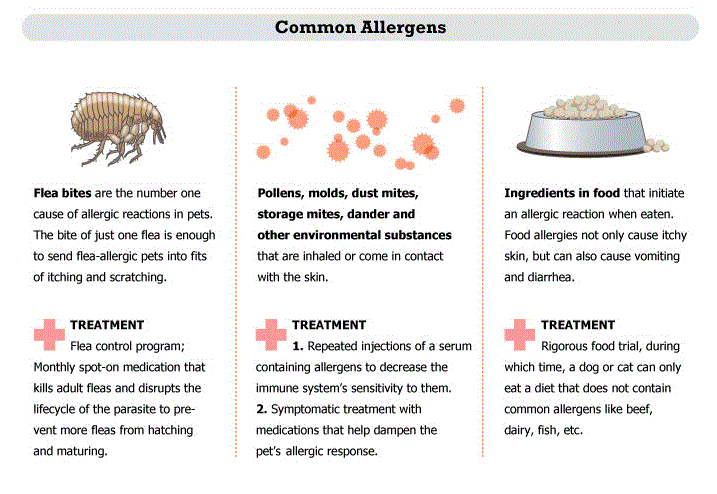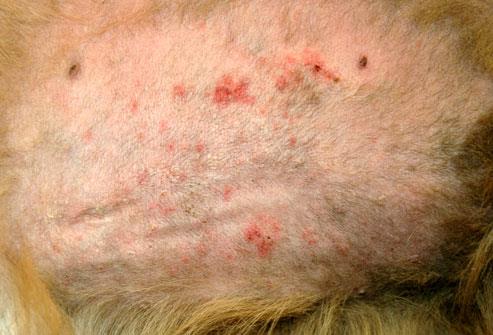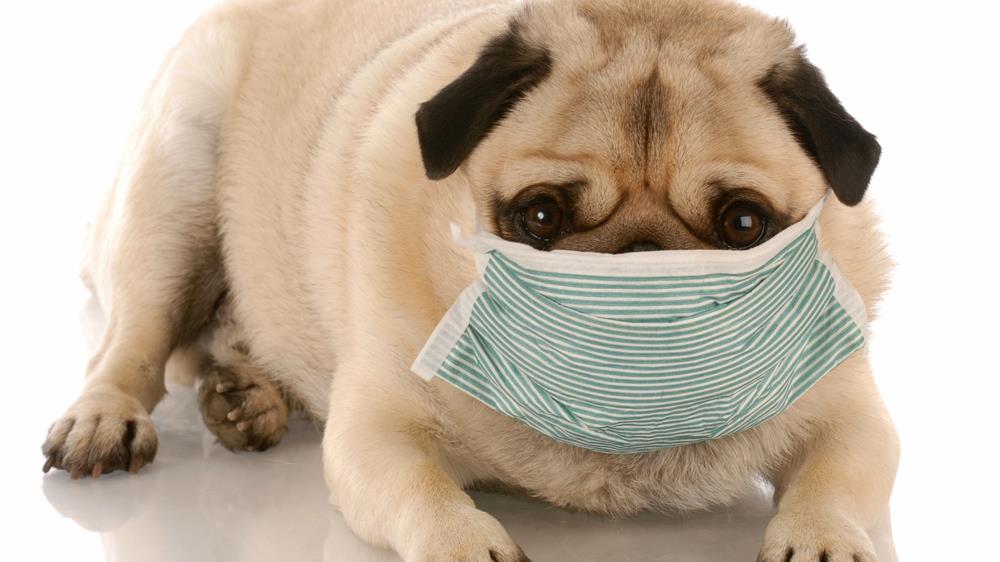Pet allergies are an immune response to substances or proteins (allergens) present in animals. These allergens may come from an animal’s skin cells, saliva, urine or fur. Common causes of pet allergies include dust mites, fleas, certain foods, and environmental allergens such as pollen, mould, and grasses.

The difference between human and pet allergies
The difference between human and pet allergies primarily lies in the symptoms and the allergens involved. While humans often exhibit respiratory symptoms, pets typically show skin-related symptoms such as itching, scratching, and skin inflammation. Moreover, the allergens causing reactions in pets are often different from those causing reactions in humans.
Understanding pet allergies
Understanding pet allergies is crucial in identifying signs early and seeking prompt treatment, ensuring the wellbeing of our furry friends.
The Most Common Allergens in Pets
Our furry friends, just like us, can suffer from allergies. This can be due to various factors including food, environment, and parasites. Understanding these allergens is the first step towards managing your pet’s health effectively.
Food Allergens
Food allergies in pets are typically caused by specific ingredients such as beef, dairy, wheat, egg, chicken, lamb, soy, pork, rabbit, and fish. These ingredients can lead to symptoms like itching, swelling, and gastrointestinal issues.
Environmental Allergens
Pets can also be allergic to seasonal allergens such as pollen, grass, and mould, or indoor allergens like dust mites and fabrics. These can cause skin irritations, sneezing, and coughing.
Fleas and Other Parasites
Flea allergy dermatitis is a common allergic reaction in pets caused by flea bites. Other parasites such as mites and ticks can also cause allergic reactions.
Signs and Symptoms of Allergies in Pets
Allergies in pets can manifest in various ways and it’s essential for pet owners to recognise these signs. The symptoms can be categorised into physical, behavioural, and respiratory.
Physical Symptoms
Pets with allergies often display physical symptoms. These may include skin issues such as rashes, welts, and hot spots. Hair loss or excessive scratching may also be signs your pet is dealing with an allergic reaction.

Behavioural Symptoms
Allergies can also affect your pet’s behaviour. Changes in eating habits, lethargy, or agitation can indicate an allergic reaction. If your pet’s behaviour suddenly changes, consider consulting with your vet.
Respiratory Symptoms
Lastly, pets with allergies may exhibit respiratory symptoms. Sneezing, coughing, wheezing, and other respiratory issues can all be signs of allergies. It’s important to consult a veterinary professional if these symptoms persist.
We recommend adding an infographic here, illustrating the different symptoms of pet allergies and how they manifest. This will further assist pet owners in recognising these symptoms.
Risk Factors and Predisposed Breeds
The development of allergies in pets isn’t a random occurrence. Genetics plays a significant role. Certain breeds are genetically predisposed to developing specific allergies. For instance, Golden Retrievers and West Highland Terriers are known to be more susceptible to skin allergies.
Other risk factors also contribute to the onset of allergies in pets.
Age is one, with most allergies manifesting in pets between the ages of one and three. The diet of your pet can also be a trigger, with certain foods causing allergic reactions. The environment plays a crucial role too. Exposure to allergens like pollen, dust, and mould can trigger allergic reactions.
Understanding these factors can help pet owners better manage their pets’ allergies. Regular grooming and diet control can significantly decrease the chances of an allergic reaction. Regular vet visits for early detection and treatment are also advised.
Diagnostic Tools and Techniques for Pet Allergies
Ensuring your pet’s health involves proactive measures. Regular veterinary check-ups play a critical role in identifying potential allergies. Early detection can mitigate severe reactions and help to establish effective treatment plans.
Several common diagnostic tests are vital tools in identifying allergies. Blood tests, skin tests, and dietary trials can provide conclusive evidence of an allergy, helping your vet to design a tailored treatment plan.
However, don’t underestimate the role of medical history and symptom observation in diagnosis. Noting changes in behaviour, diet or physical condition could help pinpoint the source of an allergy. For comprehensive care, combine your observations with professional veterinary input.
Recommendation for Additional Content
A visual chart of common pet allergy symptoms could greatly enhance reader understanding. This chart should include a list of symptoms, potential allergens, and recommended actions for pet owners. Mark its placement with an image placeholder.
Treatment Options for Pet Allergies
Allergies in pets can be a real concern, causing discomfort and distress. Fortunately, numerous treatment options are available.
Medical Treatments
One common approach is medical treatment. Veterinarians may prescribe antihistamines, steroids, or other drugs to manage symptoms. These medicines help to reduce inflammation and control allergic reactions, offering relief to your pet.
Dietary Changes and Hypoallergenic Foods
Another effective method is dietary changes. For pets with food allergies, veterinarians may recommend hypoallergenic foods that are less likely to trigger an allergic response.

Environmental Modifications
Lastly, reducing your pet’s exposure to allergens in their environment can be beneficial. This may involve regular cleaning, air purifiers, or allergen-reducing pet shampoos.
Remember, always consult with a vet to understand the best treatment for your pet’s specific needs.
Prevention and Management of Pet Allergies
Among the various challenges pet owners face, allergies in pets can be particularly difficult to handle. However, with the right measures, they can be prevented and managed effectively.
Regular Grooming and Cleaning
To minimise the risk of your pet developing allergies, regular grooming is essential. This includes bathing your pet frequently and cleaning its living area to reduce exposure to allergens.
The Role of Diet and Exercise
Just like in humans, a balanced diet and regular exercise can boost your pet’s immune system and prevent allergies. Numerous studies have shown that pets with a healthy lifestyle have a lower risk of developing allergies.
Long-term Management Strategies
For pets with chronic allergies, a comprehensive management strategy is key. This may involve medication, regular vet check-ups, and implementing an allergen avoidance plan.
When to Seek Veterinary Help for Your Pet’s Allergies
- Early detection and treatment of pet allergies can significantly improve your pet’s quality of life. With allergies becoming increasingly prevalent in pets, it’s crucial to understand when to seek professional help.
- Common signals that your pet’s allergies may be severe or worsening include persistent scratching, skin inflammation, recurrent ear infections, and changes in behaviour.
- Veterinarians play an integral role in diagnosing, treating, and managing pet allergies. Using various diagnostic tests, they can identify the specific allergens causing the reactions, allowing for targeted treatment plans. Regular check-ups with your veterinarian can also help monitor the effectiveness of treatments and make necessary adjustments.
In conclusion, understanding the signs of severe or worsening allergies and the importance of early veterinary intervention can greatly contribute to your pet’s wellbeing.


